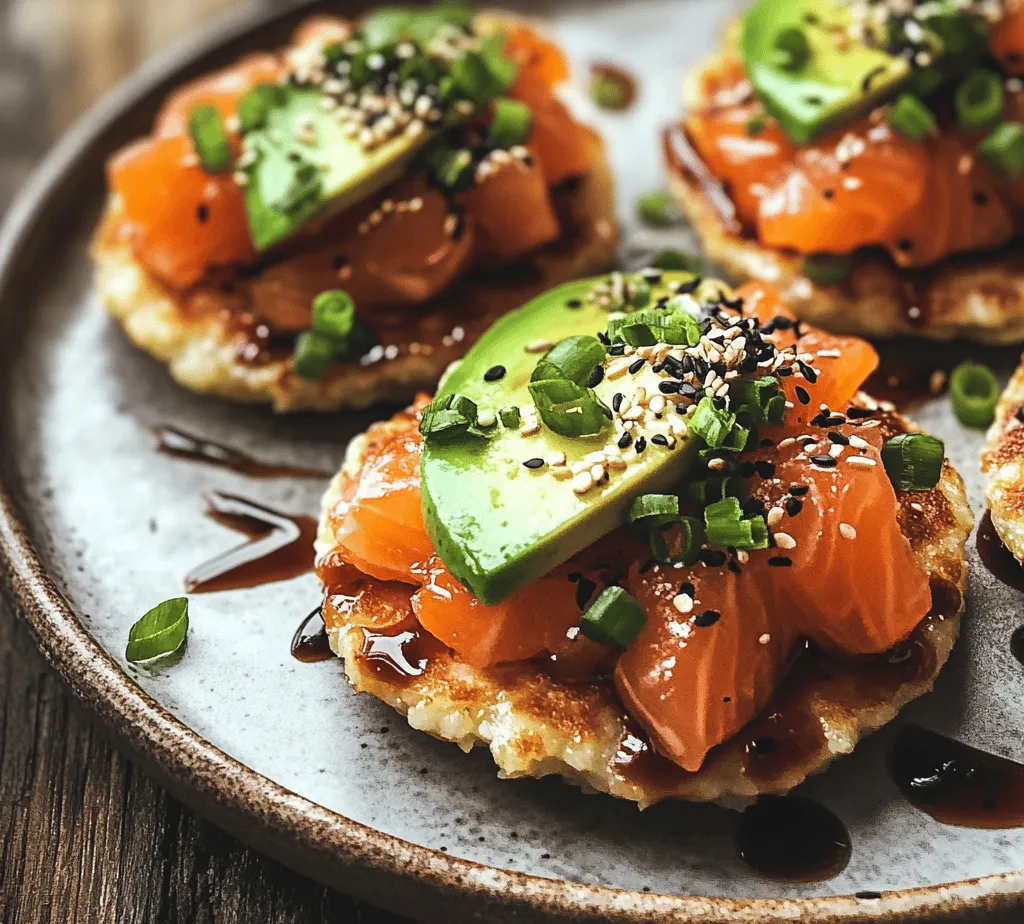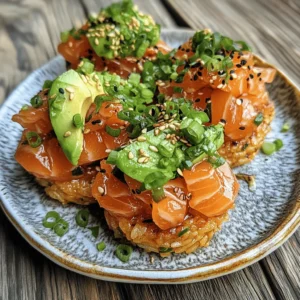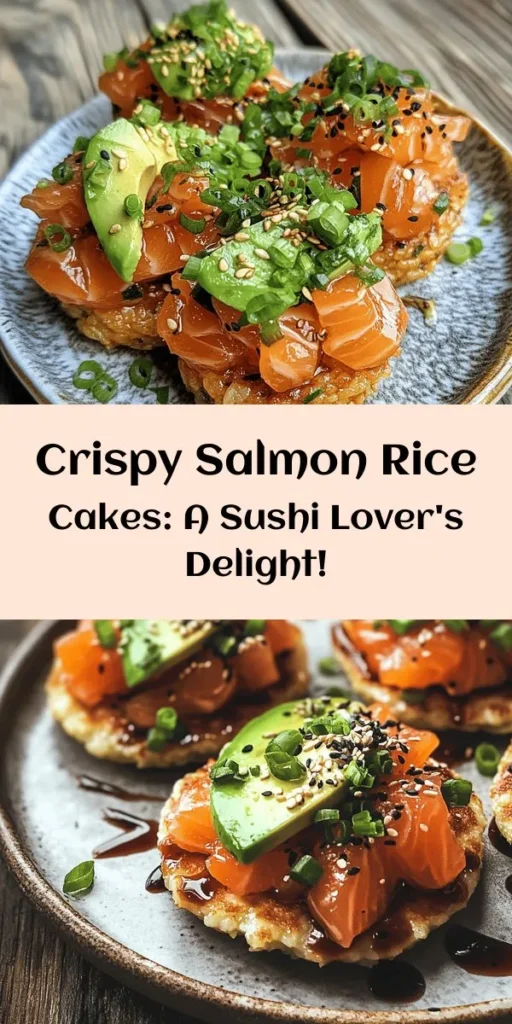In the world of culinary delights, few dishes capture the essence of freshness and flavor quite like Salmon Crispy Rice. This innovative fusion recipe brings together the classic elements of sushi with the satisfying crunch of crispy rice cakes, resulting in a dish that is not only visually appealing but also packed with taste. The combination of sushi-grade salmon, creamy avocado, and a hint of umami from furikake creates a delightful experience for the senses.
Whether you are hosting a gathering, celebrating a special occasion, or simply looking for a delightful weeknight dinner, Salmon Crispy Rice is a perfect choice. This dish showcases the best of Japanese cuisine while allowing for creativity and personalization with its toppings and presentation. In this article, we will explore the origins of this dish, the key ingredients that make it special, and provide you with a step-by-step guide to preparing this delicious meal at home.
Understanding the Ingredients
Exploring Sushi Rice and Its Importance
At the heart of Salmon Crispy Rice lies sushi rice, known for its unique properties that set it apart from regular rice varieties. Sushi rice, or “shari,” is a short-grain rice that becomes sticky when cooked, allowing it to hold its shape and be molded into various forms. The stickiness is essential for creating the perfect base for your crispy rice cakes.
To season sushi rice, a mixture of rice vinegar, sugar, and salt is used. This combination not only enhances the flavor of the rice but also adds a subtle tanginess that complements the richness of the salmon. The rice vinegar helps to balance the flavors, while the sugar and salt bring out the natural sweetness of the rice. This seasoning process is crucial for achieving that authentic sushi taste, making it an integral part of your Salmon Crispy Rice preparation.
The Star Ingredient: Sushi-Grade Salmon
No dish can claim the name “Salmon Crispy Rice” without its star ingredient—sushi-grade salmon. But what exactly does “sushi-grade” mean? Sushi-grade salmon is fish that has been frozen at specific temperatures to kill parasites and is deemed safe for raw consumption. When selecting sushi-grade salmon, it’s essential to look for fish that appears vibrant and fresh, with a firm texture and a clean, ocean-like smell.
In addition to being a delicious addition to your dish, salmon is incredibly nutritious. Rich in omega-3 fatty acids, high-quality protein, and essential vitamins and minerals, salmon offers numerous health benefits, including improved heart health, enhanced brain function, and reduced inflammation. When preparing Salmon Crispy Rice, the quality of your salmon will directly impact the overall flavor and presentation of your dish, so take your time to choose the freshest option available.
Flavor Enhancers: Soy Sauce, Sesame Oil, and Wasabi
To elevate the flavor profile of your Salmon Crispy Rice, incorporating flavor enhancers like soy sauce and sesame oil is crucial. Soy sauce adds a savory umami taste that complements the richness of the salmon, while sesame oil imparts a nutty aroma and depth of flavor to the dish. Both ingredients work harmoniously to create a well-rounded taste experience.
Wasabi is an optional ingredient that can add a zesty kick to your dish. Traditionally served with sushi, wasabi can enhance the overall flavor, but its heat level may not be suitable for everyone. If you enjoy a bit of spice, consider offering wasabi on the side so that guests can adjust the heat to their liking.
The Role of Avocado and Green Onions in Garnishing
Avocado plays a crucial role in Salmon Crispy Rice, adding creaminess and richness that balances the texture of the crispy rice and the freshness of the salmon. Additionally, avocados are loaded with healthy fats, fiber, and potassium, making them a nutritious addition to your meal.
Green onions serve not only as a garnish but also contribute to the flavor and aesthetics of the dish. Their mild onion flavor adds a refreshing crunch, enhancing the overall experience. When thinly sliced and scattered atop your Salmon Crispy Rice, green onions provide a pop of color and a burst of flavor that ties all the elements together.
Step-by-Step Preparation of Salmon Crispy Rice
Preparing the Sushi Rice
The first step in creating the perfect Salmon Crispy Rice is preparing the sushi rice. Rinsing the rice is a critical step to remove excess starch, which can make the rice overly sticky and gummy. To rinse the rice, place it in a fine-mesh strainer and run cold water over it, gently agitating the grains with your hand. Repeat this process until the water runs clear, indicating that most of the excess starch has been washed away.
Once rinsed, it’s time to cook the sushi rice. The ideal method for cooking sushi rice is to use a rice cooker, but you can also prepare it on the stovetop. If using a rice cooker, follow the manufacturer’s instructions, measuring the rice and water according to the specified ratio (typically 1 cup of rice to 1.25 cups of water). If using the stovetop, combine the rinsed rice and water in a medium saucepan and bring it to a boil. Once it reaches a boil, reduce the heat to low, cover the saucepan, and let it simmer for about 18-20 minutes or until the water is absorbed and the rice is tender.
After cooking, allow the rice to sit covered for an additional 10 minutes to steam and reach the desired texture. The rice should be tender yet firm, with a slightly sticky consistency perfect for shaping into rice cakes.
Seasoning the Rice
Once the sushi rice is cooked, it’s time to season it for optimal flavor. In a small bowl, combine rice vinegar, sugar, and salt in a ratio that suits your taste. The common ratio is ¼ cup rice vinegar, 2 tablespoons sugar, and 1 teaspoon salt, but feel free to adjust based on your preferences.
Transfer the cooked rice to a large mixing bowl and gently fold in the seasoning mixture using a spatula or wooden spoon. Be careful not to mash the rice; the goal is to evenly distribute the seasoning while maintaining the rice’s integrity. Allow the seasoned rice to cool to room temperature, as this will make it easier to shape into rice cakes later.
Forming the Rice Cakes
Creating the rice cakes is a fun part of the process that requires a bit of finesse. To prevent the rice from sticking to your hands, wet your hands with water or sprinkle them with a bit of water before handling the rice. Take a handful of the cooled, seasoned rice and form it into a compact patty. Aim for a thickness of about ½ inch, as this will yield the ideal crispy texture when fried.
Place the shaped rice cakes on a parchment-lined baking sheet, ensuring they are spaced apart to prevent sticking. Depending on the size of your rice cakes, you may need to adjust the cooking time later, so keep that in mind as you shape them.
Frying to Perfection
The final step in preparing your Salmon Crispy Rice is frying the rice cakes to achieve that perfect crispy exterior. Heat a generous amount of high smoke point oil, such as canola or vegetable oil, in a large skillet over medium-high heat. Once the oil is hot and shimmering, carefully add the rice cakes to the skillet, taking care not to overcrowd the pan.
Fry the rice cakes for about 3-4 minutes on each side, or until they are golden brown and crispy. The key is to ensure the oil is hot enough to create a crispy texture without burning the rice. Once fried, transfer the rice cakes to a paper towel-lined plate to drain any excess oil.
With your crispy rice cakes ready, you can now assemble your Salmon Crispy Rice masterpiece by topping them with sushi-grade salmon, avocado, and any additional garnishes of your choice. This dish not only promises a delightful eating experience, but it also allows for creativity in presentation, making it a standout dish for any occasion.
Stay tuned for the next part of the article, where we will explore the toppings and garnishes that elevate Salmon Crispy Rice, along with tips for serving and common questions you may have about this delicious recipe.

Choosing the Right Oil for Frying
When it comes to frying the rice cakes for your Salmon Crispy Rice, the choice of oil plays a crucial role in achieving that perfect crispy texture. For frying, it’s best to use oils with a high smoke point, which allows them to withstand the heat without burning. Recommended oils include:
– Canola Oil: A neutral flavor and high smoke point make it an excellent choice for frying.
– Peanut Oil: Known for its slightly nutty flavor and high smoke point, peanut oil can enhance the overall taste.
– Avocado Oil: This oil has a high smoke point and is rich in healthy fats, making it a great option for frying.
– Vegetable Oil: A versatile choice that works well for frying, though it may be less flavorful than other options.
Using the right oil not only ensures that your rice cakes fry evenly but also contributes to their flavor profile.
Step-by-Step Guide for Frying the Rice Cakes Evenly
1. Heat the Oil: In a large skillet or frying pan, pour enough oil to cover the bottom of the pan by about 1/4 inch. Heat the oil over medium-high heat until it shimmers. To test if the oil is ready, drop in a small piece of rice; if it bubbles vigorously, the oil is hot enough.
2. Fry the Rice Cakes: Carefully place the rice cakes in the hot oil, ensuring they are not overcrowded. Fry in batches if necessary. Cook each side for about 2-3 minutes or until they achieve a beautiful golden-brown color.
3. Flip Gently: Use a spatula to gently flip the rice cakes. Avoid using tongs, as they can break the cakes apart.
4. Drain Excess Oil: Once the rice cakes are done, use a slotted spatula to remove them from the oil. Place them on a paper towel-lined plate to absorb excess oil. This step is essential for keeping them crispy.
Identifying the Perfect Golden-Brown Color
The hallmark of perfectly fried rice cakes is their golden-brown color. This not only indicates that they are cooked through but also that they possess a delightful crunch. Look for:
– Even Color: The rice cakes should have a uniform golden-brown hue. If they are browning too quickly, lower the heat to avoid burning.
– Texture: The exterior should feel crispy when lightly tapped. If it feels soft or mushy, continue frying for a minute or two longer.
– Aroma: A nutty, toasted smell will fill your kitchen when the rice cakes are nearing perfection.
Preparing the Salmon Mixture
While your rice cakes are frying, it’s time to prepare the fresh and flavorful salmon topping that will elevate your dish.
Combining Ingredients for the Ideal Salmon Topping
1. Fresh Salmon: Start with sushi-grade salmon for the best flavor and texture. Dice the salmon into small cubes for even distribution.
2. Flavor Boosters: In a mixing bowl, combine the diced salmon with:
– Soy Sauce: Adds umami depth.
– Sesame Oil: A few drops enhance the flavor profile with nutty undertones.
– Green Onions: Finely chopped for freshness.
– Sriracha or Wasabi: Adjust to taste for a spicy kick.
3. Mix Well: Gently toss the ingredients together until the salmon is evenly coated. Be careful not to mash the salmon; you want to maintain its integrity.
Adjusting Flavors to Personal Preference
The beauty of this salmon mixture lies in its adaptability. Feel free to adjust the quantities of soy sauce or sesame oil based on your taste preferences. Adding a touch of lime juice can elevate the dish with a zesty brightness. If you’re a fan of citrus, consider incorporating a bit of yuzu or lemon for a refreshing twist.
Assembling the Dish
Once the rice cakes are perfectly fried and the salmon mixture is ready, it’s time to assemble your Salmon Crispy Rice.
Strategic Layering for Aesthetics and Taste
1. Base Layer: Start with a crispy rice cake as your base. Ensure they are still warm for optimal flavor.
2. Add Salmon Mixture: Spoon a generous portion of the salmon mixture onto the rice cake. Be sure to distribute evenly for balanced flavors in every bite.
3. Garnish: Top it off with your choice of garnishes, such as:
– Microgreens: For a fresh, crunchy element.
– Sesame Seeds: Adds a slight crunch and a nutty flavor.
– Pickled Ginger: A traditional accompaniment that balances the richness of the salmon.
Importance of Serving Immediately for Optimal Texture
To enjoy the best experience, serve the Salmon Crispy Rice immediately after assembly. The contrast of the crispy rice cake against the tender salmon and fresh toppings creates a delightful mouthfeel. If left to sit, the rice cakes can lose their crispness, making the dish less appealing.
Variations and Customizations
One of the strengths of Salmon Crispy Rice is its versatility, allowing for various adaptations based on personal taste, dietary restrictions, and ingredient availability.
Exploring Alternative Proteins
If salmon isn’t your preferred choice, consider these alternatives:
– Tuna: Another popular sushi fish that can be used in the same manner as salmon. Opt for sushi-grade tuna, diced and prepared similarly.
– Shrimp: Cooked shrimp can be diced and tossed with the same flavorings for a different seafood experience.
– Tofu: For a vegetarian option, use firm tofu, marinated in soy sauce and sesame oil, then pan-fried or grilled before dicing.
Suggestions for Vegetarian or Vegan Alternatives
For a completely plant-based twist, you can create crispy rice with ingredients like:
– Marinated Avocado: Use ripe avocado seasoned with lime juice and sea salt.
– Roasted Vegetables: Think bell peppers, zucchini, or mushrooms that add depth and flavor.
– Chickpea Salad: A mix of mashed chickpeas, tahini, lemon juice, and spices can provide a hearty topping.
Experimenting with Toppings
To make your Salmon Crispy Rice even more exciting, explore different toppings:
– Spicy Mayo: A mix of mayonnaise and sriracha for a creamy, spicy kick.
– Cilantro or Mint: Fresh herbs add brightness and flavor.
– Furikake: A Japanese seasoning blend of dried fish, sesame seeds, and seaweed for a savory crunch.
Incorporating Seasonal Ingredients
As you become more comfortable with this recipe, consider adapting it based on seasonal availability. Utilizing fresh, local produce not only enhances the flavor but also supports sustainable eating practices.
– Spring: Add fresh peas or asparagus for a pop of color and flavor.
– Summer: Incorporate diced tomatoes or corn for sweetness.
– Fall: Use roasted squash or pumpkin seeds for a warm, hearty element.
– Winter: Experiment with root vegetables or hearty greens like kale or collards.
The Cultural Significance of Crispy Rice Dishes
As we enjoy the culinary delights of Salmon Crispy Rice, it’s essential to recognize the cultural significance behind dishes like this.
A Brief History of Sushi and Its Evolution
Sushi has deep roots in Japanese cuisine, originating as a method of preserving fish in fermented rice. Over centuries, this evolved into various styles of sushi, reflecting regional ingredients and culinary practices.
Today, sushi has transcended its traditional boundaries, becoming a global phenomenon with countless adaptations and interpretations. This evolution mirrors the cultural exchanges that occur in modern dining, where ingredients and techniques blend seamlessly.
The Rise of Fusion Cuisine
The popularity of crispy rice dishes exemplifies how cultural blending enhances culinary experiences. Salmon Crispy Rice is a perfect representation of fusion cuisine, combining elements of traditional Japanese sushi with contemporary cooking techniques. This dish is not only delicious but also a testament to the creativity and innovation in the kitchen, appealing to a diverse audience.
Conclusion
Salmon Crispy Rice is more than just a dish; it’s an expression of culinary artistry that brings together the finest ingredients and innovative techniques. With its crispy exterior and fresh, flavorful toppings, this recipe is sure to impress both family and friends. By understanding the nuances of each ingredient and following the detailed preparation steps, you can create a memorable dining experience right in your kitchen. Whether enjoyed as an appetizer or a main course, Salmon Crispy Rice is a delightful addition to any meal, promising satisfaction with every bite.



